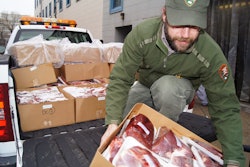
According to the U.S. Environmental Protection Agency, more food reaches landfills than any other type of municipal solid waste. The Food Waste Reduction Alliance estimates that as much as 40 percent of the food that is grown, processed, and transported in the United States will never be consumed, yet an estimated 50 million Americans do not have access to enough food. There are also environmental impacts to food waste: decomposing food in landfills releases methane, a greenhouse gas. And, according to the alliance, uneaten food in this country uses 26 percent of our freshwater resources and accounts for 4 percent of total oil consumption.
When people gather for events that include food service, inevitably waste will be generated, but there are things planners can do to mitigate the impact. BizBash asked three people with expertise in this area to share their insights: Shawna McKinley is director of sustainability for MeetGreen; Dana Siles is community service chairwoman for the New England chapter of the National Association for Catering and Events; Jeannie Power is an independent planner and director of industry relations and education for EventMobi; and Kevin Jezewski is director of sustainability and special projects for Savor Chicago at McCormick Place. Here are their tips for minimizing and handling food waste.
1. Make food waste reduction and diversion a part of your planning from the beginning.
2. Track and review attendance and consumption data from past events to help determine the type and quantities of food to order. Resist the urge to refresh buffets and self-service stations too soon. “Our goal should be to provide just the right amount. So let service staff know when you want them to refresh and that it is okay to have the food diminish,” McKinley says.
3. Choose in-season food that can be procured from local vendors to minimize the carbon footprint. Also consider integrating ingredients that consume fewer resources. Vegetarian selections can be less resource-intensive than proteins, McKinley says, and chicken, turkey, and pork have lower water and carbon footprints than beef or lamb.
4. Think about how the flow of meals might allow the caterer to make use of leftovers, such as using any unserved vegetables from the dinner buffet as a soup-starter the next day or turning extra bread into croutons.
5. Use reusable plates and flatware when possible. For disposables, choose serving ware and utensils that can be recycled or composted and that are produced by a vendor that minimizes the use of water and chemicals in production. Avoid packaging such as plastic bags, wrappers, and foil that can’t be recycled or composted.
6. Offer tumblers and hydration stations or pitchers of water instead of single-use bottled water.
7. Select caterers and venues that support sustainability initiatives and ask if they have relationships with local food pantries and can coordinate food donations. Check online resources such as Rock & Wrap It Up’s Hungerpedia, a database of thousands of agencies that accept donated food, and Feeding America, a national network of food banks.
8. Understand the Bill Emerson Good Samaritan Food Donation Act, a federal law that protects organizations and individuals from liability issues when they donate “apparently wholesome food” in good faith to a nonprofit organization. “One of the biggest reasons businesses are not donating food is because the shelters won’t accept it because they don’t know that as long as serve-safe guidelines are followed, there are no liability issues,” Siles says. She helped to create NACE New England’s Feeding Our Neighbors initiative, which educates venues, caterers, and food pantries on how to give and receive donations and also facilitates donations to nonprofits in the area.
9. Add a compost receptacle next to the traditional trash and recycling cans.
10. Communicate with your attendees about food waste before, during, and after your event. “Before our events we would email a reminder that said, ‘If you are not able to make it, please let us know so we can reduce the amount of food waste.’ That seemed to get a really good reaction,” Power says. At the event, use signage to educate attendees on your sustainability efforts, and after the event, share the data with them. In January, EventMobi and consultant Jim Spellos created the Whole Earth Calculator. Planners enter the pounds of food collected into the mobile app to calculate the number of meals provided and the amount of carbon dioxide and methane that would have been released into the atmosphere if the food had been thrown away. The app can generate a tweet that includes those calculations and a thank-you to the organization that donated the food. The app also can calculate how much carbon dioxide was averted from the total pounds of paper and plastic products that were recycled.



















